"Frank Janssen is a very skillful player, he is an all-round player"
This was Cornel Burzo's comment when asked about his opponent of round
4.
"Cornel is one of the very few European top players with the correct
attitude towards the game. He has an approach which I think is very
good. It will be most interesting to see how far he can go" and this was
Janssen's comment.
Now tell me, whom of the above actually won the game?
"I learned how to play go when I was 17 years old, that's about 29
year's ago. It was a woman-friend who told me about the game. I think I
met her first at fence-school where we both we going."
"Fencing? Are you any good?" I asked looking at the tall Dutchman.
Crossing a road in the middle of Nagoya Janssen suddenly made a couple
of lunges faints and trusts in rapid succession, and believe me, it was
fast.
"As a matter of fact at one time I was Dutch youth champion fencing,
does that answer your question?"
Janssen started playing In Den Bosch where at that time a Japanese
artist named Kouji Oguru was living. "I remember well that we all
thought of him as a kind of god. If he really was of 1-dan strength I'm
not sure but we all called him 1-dan meaning that he was way stronger
than any of us. I did play chess before picking up go but let me tell
you this the moment I learned to play go I quit chess and have not
regretted it for one moment.
Frank, what was the main attraction to go for you? What did you like
most about it when you just had started playing? Was my last question
(still walking through Nagoya while taking notes on the back of my
"staff" card).
"Well, err, I actually do not remember that very well but what I do know
is that at that time of my life go was *exactly* what I needed. The
challenge, the stimulation, it was perfect for me.
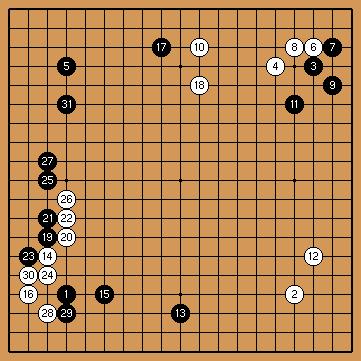
| Event |
26th WAGC, round 4 |
|---|
| Date |
2005 May 25 |
|---|
| Place |
Nagoya, Japan |
|---|
| Black |
Cornel Burzo, Romania |
|---|
| White |
Frank Janssen, the Netherlands |
|---|
| Commentary |
Hikosaka Naoto, 9p |
|---|
| Game record |
|
|---|
Figure 1: 1-31
For both players there of course were moments an alternative move could
have been chosen but the pro did not make any comment at all but just
a single "looks good". Cornel thought out loud if he should've played
something else instead of black 11 but Hikosaka sensei ensured him that
there 's nothing wrong with the game move.
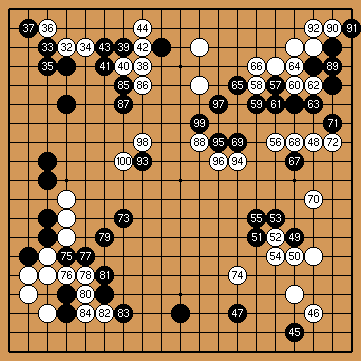
Figure 2: 32-100
Cornel did not feel happy about his move at 39 "Black lost points here,
feels like" he said a couple of times while taking away black 17 and 44.
If not for these two moves black could be satisfied but both the pro and
Cornel too felt that instead of 39 something else should be found.
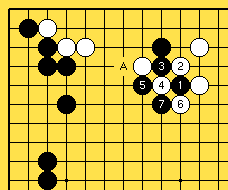
Diagram 1
Diagram 1 shows the move Hikosaka sensei came up with after all of 5
seconds. It looks a bit crazy but if for example white were to make a
ponnuki with 6 black plays atari once and when white connects at 1 comes
back at A. Black 's profit is considerable.
Instead of black 45 playing at 47 is easier. Black didn't like the
extra profit white can make in that case but Hikosaka sensei said it
was not some to worry about. Black's moves from 59 to 63 are perfect
shape. Black 65, however, turned unexpectedly out to be the first really
questionable move of the game.
"Do you think black 65 costs him the game?" I asked Hikosaka sensei who
replied "No, it's not that bad but it has a big impact on the game,
that's for sure."
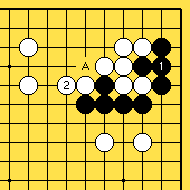
Diagram 2
In diagram 2 the best way of playing for black is shown. Because after
black 1 he is threatening to cut at A immediately white has to play
some kind of an answer, for example 2. This makes a big difference when
talking about the eye space of black's group.
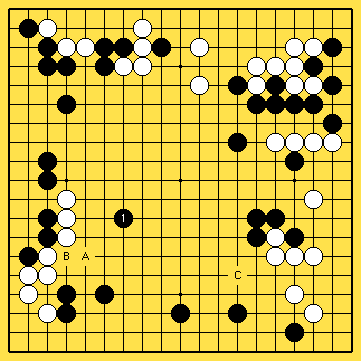
Diagram 3
Move black 1 in diagram 3 is move 73 in the diagram. This move is one of
the highlights of the game, Hikosaka 9p called it "excellent". Instead
of 1 playing at C would be honte but the pro felt that this was too slow.
Black 1 just strikes the perfect balance between how far black has to
do his best in order to stay in the game. Black at C would be slack.
The representative from Australia suggested to first make the exchange of
black A, white B before defending at C but this was not to Hikosaka's
liking since he felt that it was just not enough to stay in the game.
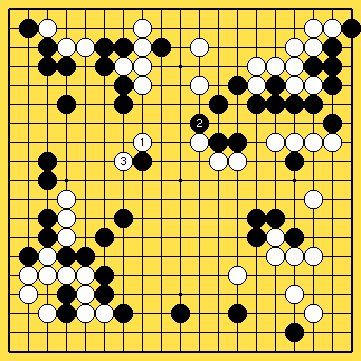
Diagram 4
If black 1 from diagram 3 was an excellent move white 1 in diagram 4 was
"marvelous". Although the game commentary went through an interpreter
most of the time "Marvelous" was actually the very word Hikosaka sensei
used in English!
The reason why white 1 is such a nice move is that because trying to
keep on attacking the black stones at the right might very well turn out
to be a dud and in the end white might end up not making much profit
whatsoever. So white found a move which does two things at once
- it threatens to eat away at black's profit at the left big time and
- it threatens to set up a most severe attack if black were to answer white 1 to the left.
So, black 2 (game move 99) is about the best thing black can do but
white adds an extra move and does substantial damage to blacks left
side.
| 






